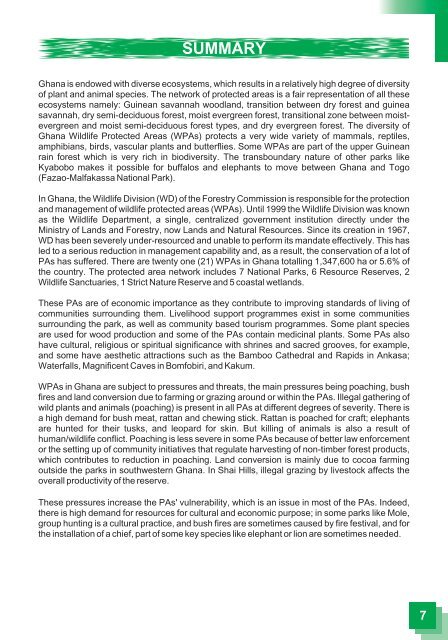Parks and reserves of Ghana: Management Effectiveness ... - IUCN
Parks and reserves of Ghana: Management Effectiveness ... - IUCN
Parks and reserves of Ghana: Management Effectiveness ... - IUCN
Create successful ePaper yourself
Turn your PDF publications into a flip-book with our unique Google optimized e-Paper software.
SUMMARY<br />
<strong>Ghana</strong> is endowed with diverse ecosystems, which results in a relatively high degree <strong>of</strong> diversity<br />
<strong>of</strong> plant <strong>and</strong> animal species. The network <strong>of</strong> protected areas is a fair representation <strong>of</strong> all these<br />
ecosystems namely: Guinean savannah woodl<strong>and</strong>, transition between dry forest <strong>and</strong> guinea<br />
savannah, dry semi-deciduous forest, moist evergreen forest, transitional zone between moistevergreen<br />
<strong>and</strong> moist semi-deciduous forest types, <strong>and</strong> dry evergreen forest. The diversity <strong>of</strong><br />
<strong>Ghana</strong> Wildlife Protected Areas (WPAs) protects a very wide variety <strong>of</strong> mammals, reptiles,<br />
amphibians, birds, vascular plants <strong>and</strong> butterflies. Some WPAs are part <strong>of</strong> the upper Guinean<br />
rain forest which is very rich in biodiversity. The transboundary nature <strong>of</strong> other parks like<br />
Kyabobo makes it possible for buffalos <strong>and</strong> elephants to move between <strong>Ghana</strong> <strong>and</strong> Togo<br />
(Fazao-Malfakassa National Park).<br />
In <strong>Ghana</strong>, the Wildlife Division (WD) <strong>of</strong> the Forestry Commission is responsible for the protection<br />
<strong>and</strong> management <strong>of</strong> wildlife protected areas (WPAs). Until 1999 the Wildlife Division was known<br />
as the Wildlife Department, a single, centralized government institution directly under the<br />
Ministry <strong>of</strong> L<strong>and</strong>s <strong>and</strong> Forestry, now L<strong>and</strong>s <strong>and</strong> Natural Resources. Since its creation in 1967,<br />
WD has been severely under-resourced <strong>and</strong> unable to perform its m<strong>and</strong>ate effectively. This has<br />
led to a serious reduction in management capability <strong>and</strong>, as a result, the conservation <strong>of</strong> a lot <strong>of</strong><br />
PAs has suffered. There are twenty one (21) WPAs in <strong>Ghana</strong> totalling 1,347,600 ha or 5.6% <strong>of</strong><br />
the country. The protected area network includes 7 National <strong>Parks</strong>, 6 Resource Reserves, 2<br />
Wildlife Sanctuaries, 1 Strict Nature Reserve <strong>and</strong> 5 coastal wetl<strong>and</strong>s.<br />
These PAs are <strong>of</strong> economic importance as they contribute to improving st<strong>and</strong>ards <strong>of</strong> living <strong>of</strong><br />
communities surrounding them. Livelihood support programmes exist in some communities<br />
surrounding the park, as well as community based tourism programmes. Some plant species<br />
are used for wood production <strong>and</strong> some <strong>of</strong> the PAs contain medicinal plants. Some PAs also<br />
have cultural, religious or spiritual significance with shrines <strong>and</strong> sacred grooves, for example,<br />
<strong>and</strong> some have aesthetic attractions such as the Bamboo Cathedral <strong>and</strong> Rapids in Ankasa;<br />
Waterfalls, Magnificent Caves in Bomfobiri, <strong>and</strong> Kakum.<br />
WPAs in <strong>Ghana</strong> are subject to pressures <strong>and</strong> threats, the main pressures being poaching, bush<br />
fires <strong>and</strong> l<strong>and</strong> conversion due to farming or grazing around or within the PAs. Illegal gathering <strong>of</strong><br />
wild plants <strong>and</strong> animals (poaching) is present in all PAs at different degrees <strong>of</strong> severity. There is<br />
a high dem<strong>and</strong> for bush meat, rattan <strong>and</strong> chewing stick. Rattan is poached for craft; elephants<br />
are hunted for their tusks, <strong>and</strong> leopard for skin. But killing <strong>of</strong> animals is also a result <strong>of</strong><br />
human/wildlife conflict. Poaching is less severe in some PAs because <strong>of</strong> better law enforcement<br />
or the setting up <strong>of</strong> community initiatives that regulate harvesting <strong>of</strong> non-timber forest products,<br />
which contributes to reduction in poaching. L<strong>and</strong> conversion is mainly due to cocoa farming<br />
outside the parks in southwestern <strong>Ghana</strong>. In Shai Hills, illegal grazing by livestock affects the<br />
overall productivity <strong>of</strong> the reserve.<br />
These pressures increase the PAs' vulnerability, which is an issue in most <strong>of</strong> the PAs. Indeed,<br />
there is high dem<strong>and</strong> for resources for cultural <strong>and</strong> economic purpose; in some parks like Mole,<br />
group hunting is a cultural practice, <strong>and</strong> bush fires are sometimes caused by fire festival, <strong>and</strong> for<br />
the installation <strong>of</strong> a chief, part <strong>of</strong> some key species like elephant or lion are sometimes needed.<br />
7

















